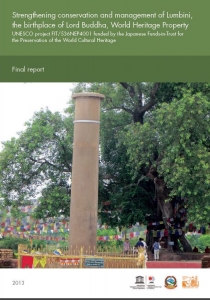
Lumbini, the birthplace of Lord Buddha, a World Heritage Property is located in the Rupandehi district of the Lumbini Zone, which is situated in the plains of Southern Nepal. Lumbini was inscribed on the World Heritage List in 1997 as the birthplace of the Lord Buddha. This is evident from the inscription on the Ashoka Pillar. The UNESCO World Heritage Property, as inscribed in 1997, is limited to an area of 130 by 150 metres around the main archaeological remains that testify to the location of the birthplace of Lord Buddha. The surrounding Buffer Zone, which is contained within a levee, has an area of approximately a quarter of a sq-km. This area is known as the Sacred Garden of Lumbini. The Sacred Garden in Lumbini is one of the most holy and significant places for one of the world’s great religions and its nomination was founded on the importance of the archaeological remains of the Buddhist viharas and stupas from the third century BCE to the fifteenth century CE, which provide important evidence about the nature of Buddhist pilgrimage centres from a very early period. The inscribed World Heritage Property area and the buffer zone are imbedded in the larger area of the master plan (five by five mile area) created by a Japanese Architect Kenzo Tange in 1978, including a one by three mile area on a north-south axis, conceived as a processional approach to the Asoka Pillar, contained within the World Heritage Property. The Government of Nepal entrusted the implementation of the Kenzo Tange Master Plan to the Lumbini Development Trust (LDT). The project was designed based on the outcomes of a preparatory mission undertaken from 18 to 21 June 2009 under JFIT funding and the activities were prioritized during the ongoing process of preparing the Integrated Management Plan (IMP). The project activities were designed to ensure that, within the limits of the budget available, decisive steps are taken towards the protection of the site. The project took into account the most urgent and critical works focusing on conserving the Outstanding Universal Value of the site and protecting it from any irreversible negative impacts.
